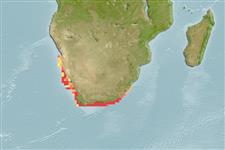Classification / Names
Common names from other countries
Main reference
Size / Weight / Age
Max length : 22.0 cm SL male/unsexed; (Ref. 91762)
Environment
Marine; pelagic-neritic; depth range 0 - 200 m (Ref. 5286)
Climate / Range
Subtropical, preferred 20°C (Ref. 107945); 17°S - 35°S, 12°E - 31°E
Distribution
Short description
Dorsal
spines
(total): 0;
Dorsal
soft rays
(total): 18-20;
Anal
spines: 0;
Anal
soft rays: 12 - 13;
Vertebrae: 50. Numerous branchiostegal rays (11 to 15); without pre-and post pelvic scutes; W-shaped pelvic scute; rectangular pre-maxillae; pelvic fins less advanced and the isthmus with lateral flanges or `shoulders' as compared to Dussumieria.
IUCN Red List Status (Ref. 115185)
Threat to humans
Harmless
Human uses
Fisheries: highly commercial
More information
ReferencesAquacultureAquaculture profileStrainsGeneticsAllele frequenciesHeritabilityDiseasesProcessingMass conversion
Tools
Special reports
Download XML
Internet sources
Estimates of some properties based on models
Phylogenetic diversity index
PD50 = 0.5098 many relatives (e.g. carps) 0.5 - 2.0 few relatives (e.g. lungfishes)
Trophic Level
3.4 ±0.45 se; Based on food items.
Resilience
High, minimum population doubling time less than 15 months (K=0.7)
Vulnerability
Low vulnerability (17 of 100)
Price category
